#livestock pond construction
Explore tagged Tumblr posts
Text
The Mage's Lantern Worldbuilding
◇▪︎ Darune Town ▪︎◇
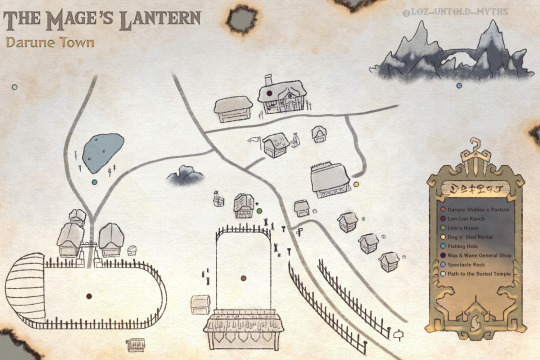
Concept map (2024).
Darune Town (also known as Darune Village among the townspeople) is a settlement constructed where one was previously devastated by the Silver Tempest and swarms of monsters. It is named after an ancient Sage of Fire in hopes of fortune against the severe cold Hyrule has been stricken with. It is Link's hometown and primarily run by the Link (Arnson) and Lon families.
Basic Info
Darune Town is Link's hometown.
The town has no mayor, due to only recently being recognized as a new township. Link's father Arn, however, is often treated as the equivalent of one.
Their main livestock consists of Highland Cows that used to roam Hyrule Field. They also raise horses, although they're only of use for deliveries along the Stone Road (a pathway constructed throughout the plains of Hyrule Field). Usually, dogsleds are used for shorter travels; especially when going to retrieve materials. Alternatively, there are a select few fishing spots with Hyrulean Salmon that were trapped by the cut-off of a stream.
Construction
During the arduous construction, entire sections of the snow would be dug and re-dug each morning, as well as the thick layers of ice formed over the soil by the Silver Tempest. This was to prevent any misconceptions in the building process: to make sure nothing relied on the packed snow for support.
If the snow were to ever disappear, the buildings would still be structurally sound– they are supported by layers of carved stone. The paths used for the horses are, as well. Darune’s roads have step-like borders, they just are never visible due to the snow’s buildup. Sometimes, not even the elevated pathways are really visible... that's where the sled rental service comes in.
Torches are posted along the roads, but are snuffed out quickly. Only certain spots have lanterns, as it's more important to keep the public spaces visible in the event of an emergency. The lamppost man's sole job for the town is to run across the town keeping all the torches and lanterns lit, night and day. Occasionally, he likes to do hearth and chimney inspections just to be doing something else...
The ranch and stables are given a sort of “roof” that is made of retractable but sturdy tiles, requiring multiple people to deploy and remove. They took years to make, but the project was funded by the King once he heard of the effort (he believed it would be vital for other remaining settlements to be able to replicate). Lanterns are meant to try and simulate natural light for the horses and cows as well as keep them warm– Epona likes to rub her face against them despite Arn's efforts to discourage the habit.
Most of the village has cellars for the winter and days of particularly unfortunate weather. The cellar doors, instead of being built at ground level, are built on elevated cobble pillars against the cellar chimneys. They're more so storm shelters.
Origin
Darune Village was built after the collapse of many homes in the general area during the Silver Tempest's awakening.
The town was built specifically with the storm in mind, on the backs of many hardworking and determined individuals. So much work went into the construction that it is rumored that some of the volunteers died on site from exhaustion.
Location Info + Climate
Darune is in a region of Hyrule Field called the Greater Hyrulean Plains, making it one of the closest settlements to the eye of the Silver Tempest.
The pond has been cut off from the stream that originally let water in from the river, so some villagers gather snowfall in a bucket to turn into boiling water for drinking.
The pond also has been almost entirely frozen over in a thick top layer, except for the center area. The center area's ice is much thinner, so it may break if disturbed for too long. There have been cases of people falling in and becoming ill.
Before the tempest, the Darune area tended to be around 76° average during the summer and about 33° average during the winter. Now, the summer average is 30°, and the winter average is only 17° at best and -32° at worst. Winters are unlivable across Hyrule and become a sort of lockdown, and in late autumn, the king usually issues out supplies rationed throughout the year to minimize how many people must starve. Castle Town folks have it even worse, but at least have easier access to trade routes.
Luckily, Darune mostly gets snow or ice rain rather than the Castle Town or Hebra Region's persistent hailstorms. This makes it a safe travel spot for those who accidentally find themselves off the Stone Road, but since the only "inn" is just a rest stop with two beds, villagers just take turns letting people rest in their homes.
The Temple of Time
The Temple of Time was what connected the old village to Castle Town. It was the site of many ceremonies, especially weddings; it was said to be representative of the Spirit Maiden, Hylia, and her eternal love for a mortal soul destined to meet her again throughout time (a common Hyrulean fairytale).
The Temple closed its doors to the public shortly before the Silver Tempest came about.
Around the time Darune was built, the Temple's upkeep seemingly stopped. However, village children still insist they see shadows crawling towards it on clear nights... which adults don't really believe, since there aren't often clear nights anymore.
Within the Temple of Time, Link finds a chamber dedicated to heroes of the past: spirits and fae who guided heroes to meeting Hylia in the past. The center of the room holds a little lantern, containing the fire spirit, Searis. Link has no idea why the spirit was locked inside or who placed him there... but perhaps he is the key to saving his village from their neverending struggle to survive?
Spectacle Rock
The village's primary source of Rock Salt. Ore deposits often appear from the strange stone.
Residents (NPCs)
Link and his family know just about everyone in town. It's small, after all. Some NPCs may be recognizable. Others, not so much.
Link
Arn
Aryll
Malon
Talon
Ingo
Old Man Linebeck
Wane (Lamppost Man)
Kyndlewax
Wulf
Dot
❄️ NPC art post will be linked here once completed. ❄️
Side Quests
If I got to actually format The Mage's Lantern as a game without Nintendo having my head, there would be a slightly longer beginning section similar to that of Ordon Village in Twilight Princess. This would include the chance to do a series of sidequests before Link wanders to Spectacle Rock.
❄️ Chapters 1-6 as a game. ❄️ (WIP)
Includes: Warm Apology, Horse Training, A Fishy Situation
. . .
Warm Apology (Quest Get)
I was supposed to spend time with Aryll today, but I completely slept through it... The least I can do is help her feel better in whatever way I can. I want to get something that'll fight off her sickness, too... but I don't have any money. People lose stuff in the snow all the time, though! Maybe I can find something...
Warm Apology (Bought Safflina)
I managed to gather enough rupees to buy the most expensive thing at Wax & Wane's General Shop. It's a flower called an Amber Safflina from somewhere far away... apparently it fights the cold (both the weather and the illness, so they say). I'm not so sure I can believe it, but I have to give it a try. They rarely have these lately... And who sees flowers anymore?! Aryll won't believe it, either!
Warm Apology (Complete)
I gave Aryll the Amber Safflina as an apology gift. She seemed really happy, so I think I'm forgiven. Phew. She even wanted to save one of them.
...
I forget that she doesn't get to go outside much until she recovers... and that she's only seen a few flowers ever. Mama used to tell me there were hundreds.
. . .
Horse Training (Quest Get)
I found Malon sneaking around the stables again, for some reason. She likes to work here with the horses instead of the cows at the ranch.
...
Anyway, that growl Papa was talking about seems to have scared all of the horses except for Epona. Now they just won't listen to Malon, even with her song. I'll have to soothe them all before they go back into the stable...
Horse Training (Complete)
I had to ride each horse back into the stables individually, but they're safe now. Malon gave them some straw so they'll stay put.
She told me not to tell, but she gave me some rupees as a reward. I tried to turn them down - she was pretty insistent... I guess these could be useful, though.
. . .
A Fishy Situation (Quest Get)
Because of the monster, not even Papa's friends can keep on track... It really must be bad. Usually, Papa's the sort of leader to get anybody on task!
I wonder if there's something I can do to help, even if Papa says different. Maybe if I ask around..
A Fishy Situation (Mystery Solved)
I asked around a little bit, and it seems like all the workers are just hungry. I think I get why they're so distracted now... but what can I bring them?
...
I guess I can find them some fish at the pond... I'm probably going to regret this, aren't I?
A Fishy Situation (Fishing Done)
It felt weird to go back to the pond after these past couple of weeks. It looks almost completely frozen over again - they must have had to re-carve the fishing holes. Would Aryll be mad at me for walking around here? Papa?
Old Man Linebeck was in his usual spot, where the ice is thick. And as usual, didn't want to be bothered. Surprisingly, he said he'd teach me to spear fish... but only a little, since I'm not paying. He was fuming every time I slipped up, but he said for a price he could teach me more. Did he enjoy fishing with somebody else or not?! I just can't read that guy!
...
For now, I'm just fine with the few salmon I managed to catch. This ought to get everyone's heads back in the right place.
A Fishy Situation (Complete)
Papa managed to start a fire and grilled the salmon I brought back for the workers (after I bothered him for a little while). He let me have some, too! It was sweet and savory. I feel all warm and fuzzy inside! So flaky and delicious...
...
Oh, and everyone seemed to calm down a little.
. . .
❄️ HEY! This section will be expanded as the story progresses! ❄️
Link
Hypothetical gameplay talk aside, here is the storyline in novelized form! Chapter 7 to be released in two parts between December of 2024 and January of 2025.
#loz untold myths#loz the mage's lantern#original legends#tml darune town#untold hero of flame#temple of time#lon lon ranch#tml arn#tml npcs#npcs#zelda npcs#tloz oc#loz oc#zelda oc#link oc#oc link#zelda ocs#loz ocs#legend of zelda#loz#tloz#the legend of zelda#loz au#zelda au#legend of zelda au#zelda#tloz au#au link#epona
20 notes
·
View notes
Text

First—A School Farm
By 1993, Paul Weertz, who was a member of the Detroit Agriculture Network and the biology teacher at the Catherine Ferguson Academy (CFA), set out to transform the playground at the school into an urban farmstead. CFA is a public high school that serves young women who are pregnant or who have young children. The farm chores helped make the biology lessons real to these urban high schoolers, and the animal husbandry helped teach them lessons about the importance of proper care and nurturing for their own babies.
Over the years, CFA’s two-acre farm has become one of the jewels of Detroit’s urban agriculture movement. It consists of a central pasture with a modest shelter for horses and the occasional steer that the farm raises. Surrounding the pasture are students’ vegetable plots and a seed-saving garden. Closer to the school is a small barn that was constructed by students and volunteers a few years ago, for storage of hay and equipment. A grant two years ago allowed the farm to install a small wind turbine on the barn’s roof to power the lights in the barn.
Most accessible from the school is the barnyard which houses the poultry coops, a duck/goose pen with pond, cages for about 20 rabbits, a shed and pens for the milking goats (currently only three, but at times as many as seven), and a stall currently occupied by a visiting pygmy pig. A hoop house for extended-season growing sits nearby, surrounded by flower gardens. To the west of the pasture are a series of fruit tree orchards, and behind them are the beehives. On the north side of the farm, The Greening of Detroit organization has a fruit tree nursery, from which it removes about 1/3 of the trees each year to transplant to community gardens.
During the school year, the young women who are students at CFA do all of the animal care chores. On weekends, a small army of volunteers from across the metro area turns out to feed and water the livestock, milk the goats, harvest vegetables and fruit and press cider for sale after school on Thursdays, etc., all anxious to be a part of the growing urban farm movement.
#school farms#small farms#urban gardening#urban farming#detroit#solarpunk#small farm movement#community building#practical anarchy#practical anarchism#anarchist society#practical#revolution#anarchism#daily posts#communism#anti capitalist#anti capitalism#late stage capitalism#organization#grassroots#grass roots#anarchists#libraries#leftism#social issues#economy#economics#climate change#climate crisis
9 notes
·
View notes
Text

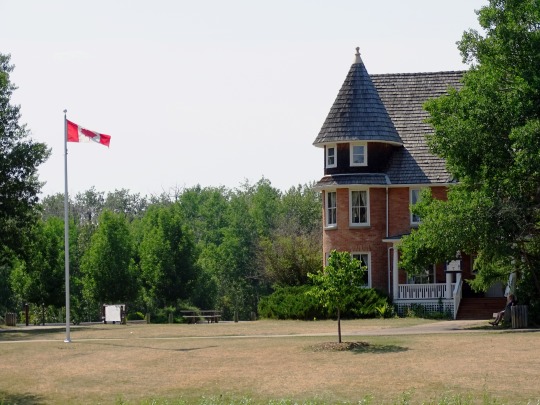

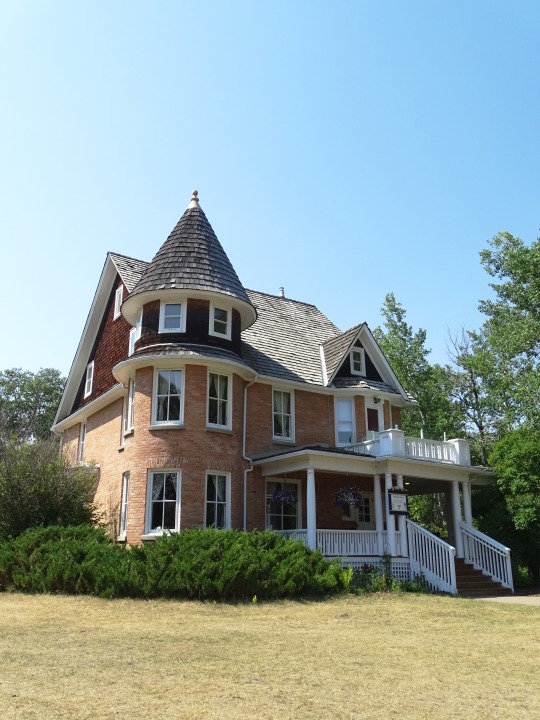
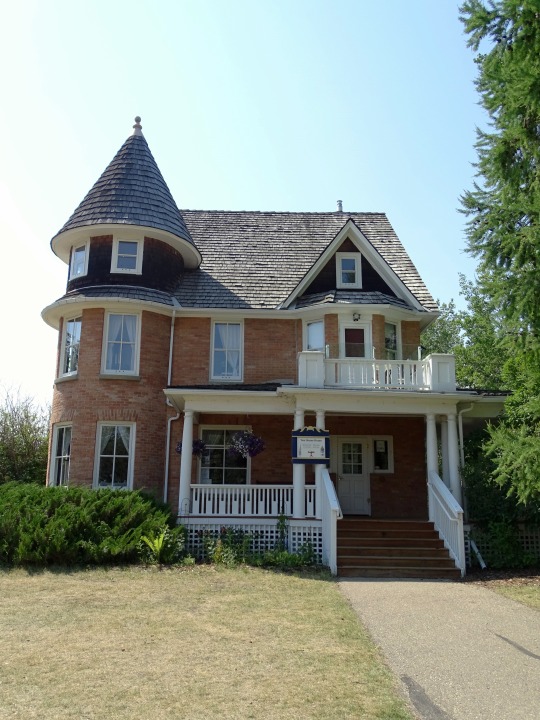
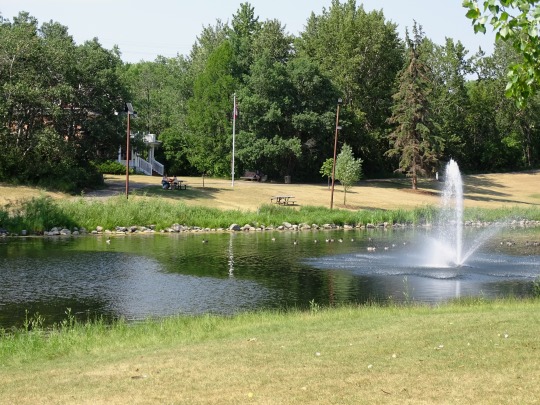
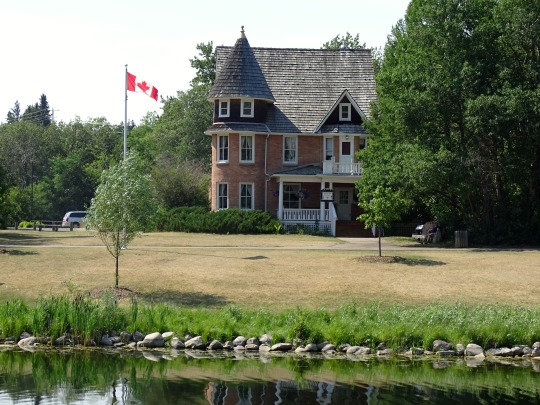
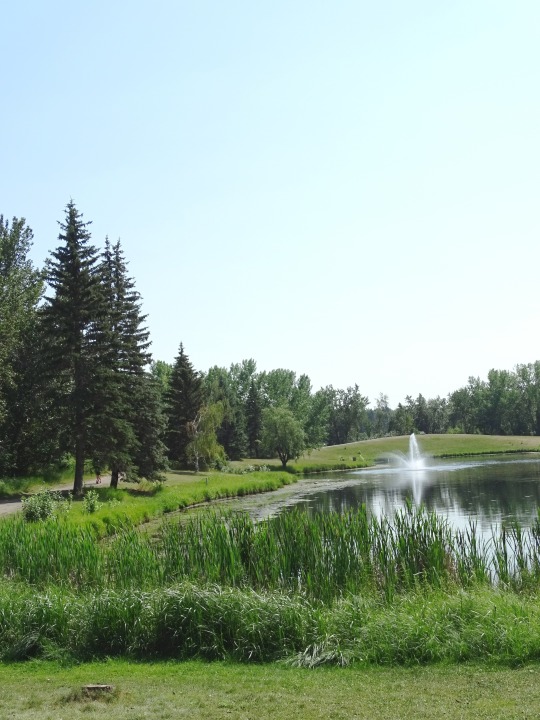
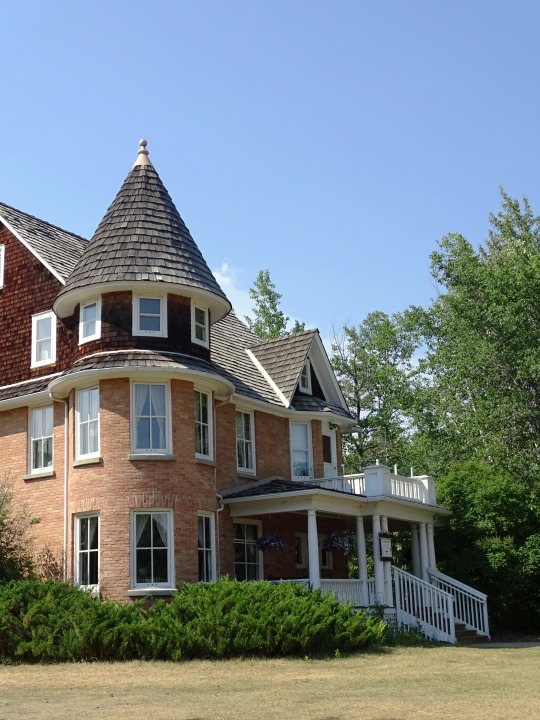
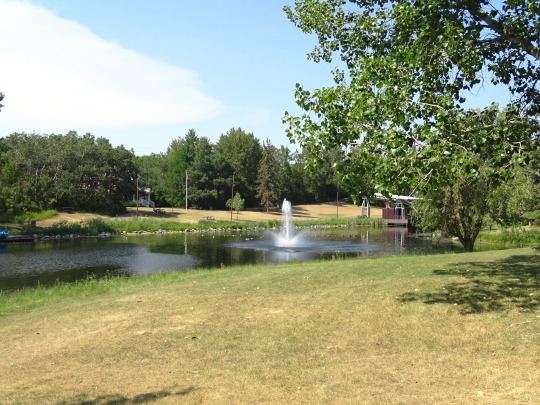
Cronquist Tea House, Red Deer
The Cronquist Family
The Cronquist House is one of the few remaining buildings in Red Deer dating from the early 1900's when the district was settled.The three story, 3500 sq. ft. Victorian-style farm house was built in what is now West Park Estates by the Cronquist family who were Swedish immigrants.
Emmanuel Pettersen Cronquist married Hilda Carlsdater in 1886 and became a successful Alberta businessman with extensive farming and livestock operations. He completed their luxurious family home in 1912 in a location with a beautiful view of the Red Deer River Valley.
The House Through Time
The house fell into disrepair due to the death of the last surviving family member in 1974. It was vacant and neglected despite being a landmark for travelers along the old Calgary- Edmonton trail.
Then the 1000 acres of land which belonged to the Cronquist family were acquired by developers who intended to demolish the house and build a new subdivision.
Where We Come In
In 1976, the Red Deer Folk Festival Society (now the Red Deer Cultural Heritage Society) was given the opportunity and took on the challenge of rescuing the now famous Cronquist House from demolition. In relocating the house to its present site overlooking the picturesque Bower Ponds, the Society created one of the first multicultural centres in Alberta.
After the move to the Bower Ponds location, the Cronquist House was completely restored. The interior decorations of the house are new, although reminiscent of the era in which the house was built, and the beautiful and extensive woodwork is original. It stands on a new basement, however, the original bricks were removed for re-location and reset at the new site. New wiring, heating and plumbing systems installed by volunteers from trades and construction professionals to citizens who simply donated their time to help out in any way they could.
From March to December, the public is invited to enjoy the ambience of the Cronquist House over delicious light lunches or afternoon tea and dessert. The house may be rented for meetings, small weddings, or other private functions.
Source
#Cronquist Tea House#Bower Ponds#Red Deer#Alberta#Canada#summer 2024#travel#original photography#vacation#tourist attraction#landmark#cityscape#Canada Geese#central Alberta#animal#wildlife#fauna#bird#landscape#architecture#bridge#fountain#boat#tree#lawn#reflection#Emmanuel Cronquist#Great Chief Park
2 notes
·
View notes
Text
Diverse Product Portfolio
A leading water pump supplier stands out by offering a diverse product portfolio that caters to a wide range of applications across residential, commercial, and industrial sectors. This variety ensures that customers can find tailored solutions for their unique needs, backed by the latest technology and engineering excellence.

Here’s an overview of what constitutes a diverse water pump product portfolio:
1. Residential Water Pumps
Applications: Domestic water supply, garden irrigation, and boosting household water pressure.
Popular Types:
Booster Pumps: Enhance water pressure for household needs.
Submersible Pumps: Ideal for wells, tanks, and underwater applications.
Centrifugal Pumps: Common for general water transfer.
Features: Compact designs, quiet operation, and energy efficiency.
2. Commercial Water Pumps
Applications: Hotels, office buildings, retail spaces, and urban water supply systems.
Popular Types:
Inline Circulation Pumps: Used in HVAC systems for heating and cooling.
Pressure Booster Systems: Ensure steady water supply in multi-story buildings.
Drainage Pumps: Handle wastewater and stormwater management.
Features: High performance, ease of maintenance, and scalable designs.
3. Industrial Water Pumps
Applications: Manufacturing plants, mining, oil and gas, power generation, and chemical processing.
Popular Types:
Vertical Turbine Pumps: Suitable for large-scale water transfer.
Multistage Pumps: Handle high-pressure requirements in industrial processes.
Dewatering Pumps: Remove water from mines, construction sites, and flooded areas.
Features: Heavy-duty construction, corrosion resistance, and adaptability to extreme conditions.
4. Agricultural Water Pumps
Applications: Irrigation, livestock watering, and drainage in farmlands.
Popular Types:
Borewell Pumps: Extract groundwater efficiently.
Surface Pumps: Transfer water from ponds, rivers, and reservoirs.
Sprinkler Pumps: Distribute water evenly for irrigation.
Features: High efficiency, durability, and ability to handle varying water qualities.
5. Specialized Pumps for Niche Markets
Applications: Unique industries or specific operational needs.
Popular Types:
Chemical Pumps: Handle corrosive and hazardous liquids.
Food-Grade Pumps: Used in food and beverage production.
Solar-Powered Pumps: Ideal for off-grid water supply systems.
Features: Custom-built designs, compliance with industry standards, and innovative technologies.
6. Smart Pumps and IoT-Enabled Solutions
Applications: Modern facilities with a focus on efficiency and automation.
Features:
Remote monitoring and control.
Energy-saving algorithms.
Predictive maintenance features.
Benefits: Improved operational efficiency, reduced energy consumption, and enhanced reliability.
7. Renewable Energy-Powered Pumps
Applications: Sustainable water supply solutions in rural or remote areas.
Types:
Solar Water Pumps: Harness solar energy for pumping water.
Wind-Powered Pumps: Use wind energy for eco-friendly water supply.
Benefits: Reduced dependence on traditional energy sources, lower operating costs, and environmental sustainability.
8. High-Capacity Pumps for Infrastructure Projects
Applications: Municipal water supply, flood control, and large-scale irrigation.
Popular Types:
Axial Flow Pumps: Move large volumes of water at low heads.
Split-Case Pumps: Reliable for high-flow applications.
Features: Robust designs, low maintenance, and long service life.
9. Wastewater and Sewage Pumps
Applications: Wastewater treatment plants, sewage systems, and industrial wastewater management.
Popular Types:
Submersible Sewage Pumps: Handle solid-laden wastewater efficiently.
Sludge Pumps: Designed for thick and viscous sludge.
Features: Anti-clogging designs, corrosion resistance, and high-capacity handling.
10. Accessories and Spare Parts
Range Includes:
Pump controllers.
Pressure vessels.
Seals, bearings, and impellers.
Benefits: Ensures the longevity and efficient operation of pump systems.
Benefits of a Diverse Product Portfolio
Comprehensive Solutions: Meet varied customer needs across different sectors.
Enhanced Efficiency: Access to specialized pumps for specific applications ensures optimal performance.
Cost-Effectiveness: A wide range of options allows customers to choose products that fit their budgets and requirements.
Future-Ready: Availability of smart and renewable-powered pumps positions the supplier as a leader in innovation.
A diverse product portfolio is a hallmark of a leading water pump supplier. By offering solutions for residential, commercial, industrial, and specialized applications, these suppliers cater to a wide array of customer needs. Their ability to integrate advanced technologies, sustainability, and customization ensures they remain at the forefront of the industry. For more info contact Water Pump Suppliers in UAE or call us at +971 4 2522966.
0 notes
Text
Transforming Your Property: Expert Land Clearing Services in Kerrville, Texas
Land clearing plays a vital role in property development, agricultural projects, and environmental management. In Kerrville, Texas, where diverse terrains and landscapes require careful attention, professional land clearing services ensure your land is optimized for its intended purpose. Whether you're preparing for construction or improving usability, land clearing is the first step toward unlocking your property’s potential.
Why Land Clearing is Essential
Land clearing involves the removal of trees, brush, stumps, and debris from your property. Here’s why it’s critical:
Prepares Land for Development: From residential housing to commercial buildings, land clearing provides a clean slate for construction projects.
Improves Usability: Overgrown land is often unusable. Clearing enhances accessibility and functionality for agricultural or recreational purposes.
Promotes Safety: Eliminating dead trees, brush, and debris reduces fire hazards and minimizes the risk of pest infestations.
Enhances Property Value: A cleared and well-maintained property often attracts higher market value.
Land Clearing in Kerrville, TX: Challenges and Solutions
Kerrville’s landscape is unique, featuring rocky terrains, dense brush, and native trees. These conditions can pose challenges for land clearing projects. Experienced professionals utilize advanced equipment like mulchers, excavators, and bulldozers to navigate these complexities. Techniques such as forestry mulching provide an eco-friendly way to clear land while preserving the soil structure.
Choosing the Right Land Clearing Service
When selecting a land clearing service in Kerrville, TX, consider the following:
Experience and Expertise: Look for providers with a proven track record in handling diverse terrains.
Comprehensive Services: Ensure they offer everything from tree removal and stump grinding to debris hauling.
Eco-Friendly Practices: Opt for services that use sustainable methods, such as recycling cleared materials.
Timely and Cost-Effective Solutions: Choose a company known for efficiency and competitive pricing.
Applications of Land Clearing
Land clearing in Kerrville serves multiple purposes, including:
Residential Development: Preparing land for new homes or extensions.
Agriculture: Clearing for crop planting or livestock grazing.
Wildlife Management: Creating space for habitat restoration or conservation projects.
Outdoor Projects: Setting the stage for trails, ponds, or recreational areas.
The Importance of Hiring Professionals
DIY land clearing might seem tempting, but it often leads to incomplete or unsafe results. Professional services ensure the job is done efficiently, adhering to local regulations and environmental standards.
Conclusion
If you’re looking to maximize the potential of your property in Kerrville, Texas, professional land clearing is the key. It not only prepares your land for its intended use but also enhances its value and functionality. With experienced experts, state-of-the-art equipment, and eco-friendly practices, you can transform your property into a space that aligns with your vision.
Contact us today to learn more about our comprehensive land clearing services in Kerrville, TX, and get started on your next project!
0 notes
Text
The Versatile Uses of Bentonite: A Comprehensive Guide

Bentonite is a highly versatile natural clay with a wide range of industrial, environmental, and personal care applications. Known for its absorbent and swelling properties, bentonite plays a significant role in various industries worldwide. This article explores the diverse bentonite uses, highlighting its importance and benefits in different sectors.
What is Bentonite?
Bentonite is a type of clay formed from volcanic ash and consists primarily of montmorillonite. It is known for its unique ability to absorb and retain water, making it invaluable in numerous industries. Available in two primary types, sodium bentonite and calcium bentonite, each variety offers distinct properties suitable for specific applications.
Top Industrial Bentonite Uses
1. Drilling Fluids in Oil and Gas Exploration
One of the most prominent bentonite uses is in the oil and gas industry. Sodium bentonite is widely used as a drilling fluid additive to cool drilling equipment, stabilize boreholes, and transport drill cuttings to the surface. Its viscosity and gel-like properties make it indispensable in this field.
2. Foundry Sand Binders
In the foundry industry, bentonite serves as a binder for molding sand. It enhances the strength and thermal stability of molds, ensuring the production of high-quality metal castings. This application is especially crucial in automotive and heavy machinery manufacturing.
3. Construction and Civil Engineering
Bentonite uses extend to the construction sector, where it is employed in waterproofing and sealing projects. Sodium bentonite is often used to line landfills, ponds, and tunnels, preventing water seepage. Its ability to form a durable barrier makes it an eco-friendly solution for soil stabilization and containment systems.
Environmental Applications of Bentonite
4. Waste Management
Bentonite is commonly used in waste management to line landfills and contain hazardous materials. Its impermeable nature helps prevent contaminants from leaching into groundwater, ensuring environmental safety.
5. Water Purification
The adsorptive properties of bentonite make it effective in removing impurities and heavy metals from water. It is a natural and cost-effective solution for treating industrial and municipal wastewater.
Bentonite in Agriculture
6. Soil Conditioning
Farmers use bentonite to improve soil quality and retain moisture. Calcium bentonite, in particular, enhances soil structure and nutrient retention, making it ideal for arid regions.
7. Animal Feed Additive
In the agricultural sector, bentonite is added to animal feed to enhance digestion and nutrient absorption. It also binds toxins and improves the overall health of livestock.
Personal Care and Wellness Uses
8. Skincare and Cosmetics
Calcium bentonite is a popular ingredient in skincare products due to its detoxifying properties. It is used in facial masks, cleansers, and exfoliants to absorb excess oil, unclog pores, and promote healthy skin.
9. Detoxification
Bentonite clay is consumed as a natural detoxifier to cleanse the body of toxins and improve gut health. It is often used in dietary supplements and wellness regimens for its health benefits.
Conclusion
The wide-ranging bentonite uses make it an invaluable resource across multiple industries. From oil exploration and environmental protection to personal care and agriculture, bentonite's versatility is unmatched. For businesses looking to source high-quality bentonite, Amrfeo is a trusted supplier offering superior-grade bentonite for various applications. Whether you need bentonite for industrial or personal purposes, Amrfeo ensures reliable solutions tailored to your needs.
With its unique properties and extensive applications, bentonite continues to play a pivotal role in advancing industries and improving everyday life. By understanding and leveraging these bentonite uses, companies and individuals alike can unlock its full potential for sustainable and innovative solutions.
0 notes
Text
Creating Sustainable Water Features: Stock Pond Construction Insights
At DuPre Site Services, we are proud to offer stock pond construction services to property owners throughout Central Texas. We serve Hays, Travis, Bastrop, Caldwell, Guadalupe, and Comal Counties, helping clients create functional and sustainable water features. Whether you’re a farmer looking for a reliable water source for livestock or a property owner who wants to enhance the natural beauty of your land, stock pond construction is a valuable investment.

Stock ponds are small bodies of water built to provide water for livestock, support local wildlife, or serve as an aesthetic feature. Building a stock pond requires proper planning and knowledge of the local terrain. At DuPre Site Services, we have years of experience working with Central Texas land, which helps us construct ponds that not only look great but also serve their intended purpose effectively. From selecting the right location to ensuring proper water retention, we handle every aspect of stock pond construction.
One of the key factors in constructing a stock pond is choosing the right site. A good stock pond location should have natural drainage to help fill the pond with rainwater and should be positioned where it can effectively serve its purpose. Our team carefully evaluates the land, taking into consideration factors like soil type, topography, and water flow, to determine the best spot for your pond. Proper site selection is essential to ensuring that the pond retains water effectively and stays healthy over time.
Stock pond construction also involves creating a strong and stable dam to contain the water. At DuPre Site Services, we use high-quality materials and proven techniques to build durable dams that can handle the natural conditions of Central Texas. We also focus on erosion control, which is critical to maintaining the integrity of the pond over time. By using proper grading and compaction, we make sure the pond is built to last.
In addition to providing water for livestock, stock ponds can also attract wildlife, support fishing, and add beauty to your property. They are a sustainable water feature that enhances the value of your land while contributing to the local ecosystem. Our team at DuPre Site Services works closely with clients to ensure their stock pond meets their goals, whether for agricultural use or as a beautiful natural feature.
If you’re in Hays, Travis, Bastrop, Caldwell, Guadalupe, or Comal Counties and are interested in stock pond construction, contact DuPre Site Services today. Visit our website at https://dupresiteservices.com to learn more about our services and how we can help you create a sustainable water feature on your property.
0 notes
Text
Bentonite Granules: Versatile Solutions for Agriculture and Industry
Bentonite granules are derived from bentonite clay, a naturally occurring mineral formed from volcanic ash. The granules are typically processed to create uniform, small particles that are easy to handle and apply. There are two main types of bentonite clay: sodium bentonite and calcium bentonite. Sodium bentonite is known for its superior swelling and absorption capabilities, while calcium bentonite is prized for its binding and sealing properties.
These granules are widely used in various industries because of their ability to absorb water, retain moisture, and enhance soil properties, making them ideal for both agricultural and industrial applications.

Key Benefits of Bentonite Granules
1. High Absorption Capacity
One of the standout features of bentonite granules is their high absorption capacity. Sodium bentonite, in particular, can absorb several times its weight in water, which makes it extremely useful in moisture retention applications. This property is vital in agriculture, where maintaining soil moisture is essential for crop growth and overall yield.
2. Soil Conditioning
In agriculture, bentonite granules are commonly used as soil conditioners. They improve soil texture, aeration, and moisture retention, which are crucial factors for crop productivity. By using bentonite granules, farmers can enhance the quality of their soil, promote root development, and improve plant growth. Bentonite also helps to prevent soil erosion by increasing the soil's water retention capacity.
3. Eco-Friendly and Natural
Bentonite is a natural and eco-friendly material, making it an excellent choice for environmentally-conscious applications. It does not introduce harmful chemicals into the environment and is safe to use in both agricultural and industrial settings. The eco-friendly nature of bentonite granules makes them a sustainable option for improving soil and managing water retention in various applications.
Applications of Bentonite Granules
1. Agriculture
In agriculture, bentonite granules are widely used as soil conditioners and carriers for fertilizers and pesticides. Their ability to absorb and retain water helps improve soil fertility and enhance crop growth. Additionally, they are often used to bind fertilizers and pesticides, ensuring even distribution of these substances across fields.
The slow release of nutrients from fertilizers bonded with bentonite granules enhances the effectiveness of fertilizers and reduces the risk of nutrient runoff, making it a cost-effective solution for farmers. This property ensures long-term soil health and higher crop yields.
2. Animal Feed
Bentonite granules also play a role in animal feed. They are used as binders to improve the texture of animal feed and help in the digestion process. Bentonite helps absorb toxins in animal feed, ensuring that livestock consumes healthy and nutrient-rich diets. This contributes to overall better health and performance in animals.
3. Industrial Applications
In industries, bentonite granules are used in various processes, including drilling, water treatment, and even construction. The absorption and swelling properties of sodium bentonite are utilized in drilling fluids to cool and lubricate drilling equipment while stabilizing boreholes. In construction, bentonite granules are used to seal ponds, landfills, and other containment areas, preventing water leakage.
Additionally, bentonite granules are used in water treatment to remove impurities. Their ability to absorb contaminants makes them an efficient material for treating industrial wastewater and ensuring cleaner, safer water.
4. Pond Lining and Sealing
Sodium bentonite granules are a popular choice for lining and sealing ponds, dams, and other water bodies. The granules form a waterproof barrier by swelling and sealing any cracks or gaps in the soil, preventing water from seeping through. This natural and cost-effective solution ensures long-lasting water retention without the need for artificial liners.
How to Choose the Right Bentonite Granules
When selecting bentonite granules for your specific application, consider the following factors:
Type of Bentonite: Sodium bentonite is ideal for applications requiring high absorption and swelling, such as pond sealing and drilling. Calcium bentonite is better suited for applications that require binding and sealing, such as in construction or fertilizers.
Particle Size: The size of the bentonite granules can impact their effectiveness. Finer granules are better for applications like soil conditioning and pesticide binding, while larger granules may be more effective in construction or water treatment.
Purity and Quality: Always work with reliable bentonite granules manufacturers that provide high-quality products. Ensuring the granules are free of impurities and meet industry standards will guarantee the best results for your application.
Conclusion
Bentonite granules offer a wide range of benefits for industries ranging from agriculture to construction. Their natural properties, such as high absorption, water retention, and soil conditioning capabilities, make them a valuable resource for numerous applications. Whether you’re looking to enhance soil quality, seal a pond, or treat industrial wastewater, bentonite granules provide efficient and eco-friendly solutions.
At Amrfeo, we are dedicated to providing high-quality bentonite granules that meet the needs of various industries. With a focus on quality and performance, Amrfeo ensures that our bentonite products deliver optimal results for your specific applications. Trust Amrfeo for reliable and eco-friendly bentonite solutions that enhance your operations and projects.
0 notes
Text
Plastic sheeting are used as temporary roofing, wall coverings....

Plastic sheeting, a ubiquitous material in modern life, have found applications across a wide spectrum of industries and households. Their versatility, durability, and cost-effectiveness have made them indispensable in various sectors.
Industrial Applications
Construction: Plastic sheeting are used as temporary roofing, wall coverings, and underlayments during construction projects. They offer protection against weather, debris, and moisture.
Agriculture: In greenhouses and livestock shelters, plastic sheeting provide insulation, light control, and protection from the elements.
Packaging: Plastic films and sheets are used for packaging food, consumer goods, and industrial products. They offer barrier properties against moisture, oxygen, and contaminants.
Manufacturing: Plastic sheeting are used as liners for vats, tanks, and equipment, preventing corrosion and contamination.
Household Uses
Home Improvement: Plastic sheeting can be used for waterproofing basements, covering patios, and creating temporary shelters.
Gardening: They can be used as mulch, weed barriers, and pond liners.
Storage: Plastic bags and sheets are used for storing clothes, blankets, and other items.
Types of Plastic Sheeting
The type of plastic sheeting used depends on the specific application and required properties. Common types include:
Polyethylene (PE): Known for its flexibility, durability, and resistance to chemicals.
Polyvinyl Chloride (PVC): Offers good strength, weather resistance, and clarity.
Polypropylene (PP): Lightweight, durable, and resistant to moisture.
Nylon: Strong, flexible, and has good abrasion resistance.
Teflon: Non-stick, heat-resistant, and chemically inert.
In conclusion, plastic sheeting have become an essential part of our daily lives, serving a wide range of purposes.
#plastic bags#plastic sheeting#plasticmanufacturer#plastic bags south africa#clear plastic bags#plastic tubing#printed plastic bags#plastictubing#plasticsheeting#plasticbags
0 notes
Text
Seeking The Right Firm For Land Clearing? Check These Out!
Preparing land for a new project can be overwhelming, especially when trees are involved. Clearing land isn't a DIY job; it takes expertise and equipment. Picking the perfect company for the task is essential. Consider factors like experience, equipment, and project scope when deciding on the best land clearing services.
Licensed Land Clearing
Before hiring land clearing services, prioritize local or state government licensing. Unlicensed companies, no matter how skilled, signal potential trouble. Licensing demonstrates a company's commitment to following regulations and standards. Without it, you risk safety issues and project complications– especially when handling the unpredictable weight of large trees.
The Importance Of Insured Land Clearing Services
Insurance is non-negotiable when choosing reputable land clearing services. Though rare with experienced crews, accidents can happen– and they're costly. Without proper insurance, you could be held liable for property injuries or equipment damage. Insured companies demonstrate responsibility, protecting all interested parties.

A Track Record Of Success
Look for providers of land clearing services with a proven track record. A company's experience demonstrates its ability to handle projects of various sizes and complexities. Feel free to ask for references and follow up with them to get a firsthand account of the company's performance.
The Right Tools For The Job
Efficient land clearing services rely on the right equipment. The essential tools can get it done, but heavy-duty machinery is key for large-scale projects. Look for companies equipped with specialized bulldozers, backhoe loaders, and grinders – ensuring your project is completed swiftly and cost-effectively.
The Power Of Referrals
Seeking recommendations is a smart way to start your search for reliable land clearing services. Tap into your network– friends, family, or neighbors may have valuable insights into companies they've used. These firsthand experiences can point you in the right direction or help you avoid pitfalls.
Reputation Speaks Volumes
In today's digital world, a company's reputation is crucial. Land clearing services must be researched online beforehand. Don't only visit their website, but also check platforms like Google My Business, Facebook, and the Better Business Bureau for a balanced view. Reviews are a great indicator of a company's track record and consistency. Be wary of companies boasting extensive experience with very few reviews. A significant discrepancy between claimed projects and customer feedback can be a warning sign.
Beyond The Cost
While budget matters, prioritize insurance, safety, and licensing when selecting land clearing services. Bargain-basement prices can signal hidden costs– think faulty equipment, worker injuries, or even scams. A reputable company's lowest quote may offer smart savings, like carrying away the debris after the clearing work. Additionally, this approach reduces hauling costs and provides natural weed control benefits.
Clear The Way With RK&R Dozer Service
RK&R Dozer Service has the expertise to handle land clearing projects of any size. We prioritize safety, hold all necessary licenses and insurance, and work with top-of-the-line equipment. Our commitment to quality and customer satisfaction is evident in every project. Don't let overgrown land hold you back. Contact us today for a free land clearing services consultation and let us help you bring your vision to life!
#oklahoma pond construction#building pond with dozer#land clearing oklahoma#livestock pond construction
0 notes
Text
Installing HDPE Pond Liners on Sloped Terrain: Tips and Techniques
Introduction
Installing High-Density Polyethylene (HDPE) pond liners on sloped terrain requires careful planning and execution to ensure the durability and effectiveness of the liner. HDPE liners are popular for pond construction due to their flexibility, strength, and resistance to chemicals and UV radiation. When dealing with sloped terrain, additional considerations and techniques are necessary to prevent slippage, maintain structural integrity, and achieve a watertight seal. Pond liner exporters in Gujarat play a crucial role in providing high-quality HDPE liners to meet the demand for durable and reliable pond construction materials. Their expertise ensures that these liners can be effectively installed on various terrains, including sloped surfaces, ensuring long-lasting and efficient pond structures.
Uses and Applications
HDPE pond liners are widely used in various applications such as: Farm Ponds: for irrigation and livestock watering. Decorative Ponds: in landscaping and garden features. Wastewater Ponds: for treatment and containment. Aquaculture Ponds: for fish farming and aquaponics. Reservoirs: for water storage and conservation. Their versatility and durability make them suitable for both commercial and residential projects.
Benefits and Advantages
The advantages of using HDPE pond liners on sloped terrain include: Flexibility: HDPE liners conform to irregular shapes and terrain. Strength: They resist punctures, tears, and stress cracking. Chemical Resistance: Suitable for various water types, including saline or chemically treated water. UV Resistance: Long-lasting performance in outdoor environments. Cost-Effective: Compared to concrete or clay liners, HDPE liners offer a more economical solution. Pond liner manufacturer in Gujarat specialize in producing cost-effective HDPE liners, providing durable and budget-friendly options for pond construction projects. Installation Efficiency: Quick and relatively straightforward installation process.
Tips and Techniques
Site Preparation: Clear the area of debris, rocks, and sharp objects. Ensure the slope is stable and free of erosion. Consider erosion control measures if necessary.
Liner Selection: Choose a high-quality HDPE liner appropriate for the slope and size of the pond. Ensure the liner thickness is adequate for the intended use.
Liner Placement: Start laying the liner from the lowest point and work upwards. Use gentle folds and creases to accommodate the slope without stretching the liner excessively. Avoid sharp bends or folds that could compromise the liner's integrity.
Securing the Liner: Anchor the liner using anchor trenches, batten strips, or mechanical fasteners. Use appropriate sealing techniques at seams and edges to prevent leakage.
Protection and Covering: Protect exposed liner surfaces from UV radiation using shading or protective coatings. Use geotextile or protective padding under the liner to cushion against sharp rocks or roots.
Monitoring and Maintenance: Regularly inspect the pond for signs of wear, tear, or damage. Address any issues promptly to prevent further deterioration.
Conclusions
Installing HDPE pond liners on sloped terrain requires careful attention to detail and adherence to best practices. When properly installed, HDPE liners provide a durable and effective solution for water containment and conservation in various applications. Their flexibility, strength, and chemical resistance make them a preferred choice for ponds on sloped surfaces. Pond liner manufacturers in Ahmedabad play a critical role in supplying high-quality HDPE liners tailored for specific project needs. These manufacturers offer expertise in liner design, fabrication, and installation techniques, ensuring the liners can conform to the contours of sloped terrains while maintaining integrity and leak-proof functionality. With reliable HDPE liners from manufacturers in Ahmedabad, pond construction projects benefit from enhanced durability and cost-effectiveness.
FAQs
Q1: Can HDPE liners be used in extremely cold climates? A1: Yes, HDPE liners are designed to withstand a wide range of temperatures and are suitable for cold climates when properly installed.
Q2: How long do HDPE pond liners last? A2: HDPE liners can last upwards of 20 years or more with proper maintenance and care.
Q3: Can HDPE liners be repaired if punctured? A3: Yes, small punctures or tears can often be repaired using patch kits specifically designed for HDPE liners.
In summary, installing HDPE pond liners on sloped terrain requires expertise and attention to detail. By following recommended tips and techniques, you can ensure a successful installation that provides long-lasting performance and reliability.
0 notes
Text

Unlocking Tranquility: Cheap Ways to Build a Pond in Your Yard
Embrace Serenity in Your Backyard
Dreaming of a serene oasis right in your backyard? Building a pond is the perfect way to create a tranquil retreat without breaking the bank. In this guide, we'll explore affordable methods to transform your outdoor space into a haven of peace and natural beauty. Whether you're a seasoned gardener or a novice enthusiast, these budget-friendly techniques will help you embark on your pond-building journey with ease.
1. Planning Your Pond: Vision and Strategy
1.1 Visualizing Your Dream Pond
Before diving into construction, take a moment to envision your ideal pond. Consider its size, shape, and location within your yard. A well-thought-out plan will guide you through the process and ensure your satisfaction with the end result.
1.2 Choosing the Right Spot
Selecting the perfect location for your pond is crucial. Look for an area with ample sunlight and minimal tree cover to encourage healthy plant growth and discourage algae. Additionally, avoid placing your pond near trees with invasive root systems to prevent future complications.
2. Pond Construction: Affordable Techniques
2.1 DIY Liner Solutions
Rather than splurging on expensive preformed liners, opt for cost-effective alternatives such as PVC or rubber pond liners. These materials are readily available at most hardware stores and can be easily customized to fit the dimensions of your pond.
2.2 Utilizing Recycled Materials
Get creative with your pond construction by repurposing old bathtubs, livestock troughs, or even large containers. Not only does this approach save money, but it also adds a unique touch to your backyard landscape.
3. Enhancing Aesthetics: Budget-Friendly Décor Ideas
3.1 Incorporating Natural Elements
Embrace the beauty of nature by incorporating rocks, driftwood, and native plants into your pond design. These elements not only enhance aesthetics but also provide habitat for beneficial wildlife such as frogs and dragonflies.
3.2 DIY Water Features
Add a touch of whimsy to your pond with DIY water features like bubbling fountains or cascading waterfalls. With a bit of creativity and ingenuity, you can create stunning focal points without breaking the bank.
4. Maintenance and Care: Keeping Your Pond Thriving
4.1 Eco-Friendly Cleaning Solutions
Maintaining a healthy pond doesn't have to involve harsh chemicals. Opt for eco-friendly cleaning solutions such as barley straw or beneficial bacteria tablets to control algae and promote water clarity.
4.2 Regular Maintenance Routine
Stay on top of pond upkeep by establishing a regular maintenance routine. Tasks such as skimming debris, trimming plants, and checking equipment should be performed on a weekly or bi-weekly basis to keep your pond looking its best.
Conclusion: Embrace Nature on a Budget
Transforming your yard into a tranquil paradise doesn't have to break the bank. By following these affordable methods for building and maintaining a pond, you can create a haven of peace and natural beauty right in your own backyard. Embrace the serenity of flowing water, vibrant plants, and the soothing sounds of nature without overspending. Start your pond-building journey today and unlock the tranquility that awaits!
FAQs
Q1: Can I build a pond in any size yard? Yes, ponds can be scaled to fit yards of all sizes. Whether you have a small urban space or a sprawling rural landscape, there are options available to suit your needs.
Q2: How much does it cost to maintain a backyard pond? The cost of pond maintenance can vary depending on factors such as size, complexity, and location. However, by utilizing budget-friendly techniques and eco-friendly practices, you can keep maintenance costs to a minimum.
Q3: Will a backyard pond attract mosquitoes? While stagnant water can attract mosquitoes, proper maintenance and the addition of mosquito-eating fish can help mitigate this issue. Additionally, incorporating moving water features such as fountains or waterfalls can deter mosquitoes from laying their eggs.
0 notes
Text


For about the last fortnight I've been supremely fascinated with an area local to me, a former stone quarry which is now a piece of barren, rocky land. The village was named after one of the quarries, 'Magnum Bonum', and was operational for between 100 and 120 years, starting around 1830. Forty houses were built to accommodate the quarrymen and their families, literally a stone's throw away from their place of work which is marked out as the triangular shape in the map pictured above. At each corner of the triangle was a pub, and further up on the right there was a jail! There were also a few shops, a chapel (mission), and a "cat pond", which I have since learnt was, sadly, a place to dispose of unwanted kittens.
Demolition of the houses in the 1930s and was completed twenty years later. The dismantling of the once-thriving community was due to the implementation of a policy regarding a nearby reservoir which had been put in place to ensure that no contaminated water could seep through into what was designated to eventually become drinking water. Livestock were banned from grazing on the land for the same reason. The quarries closed in the 1950s due to the impact of two World Wars and concrete being used in the construction industry instead of stone.
Info from Julia Hinchliffe's 'Magnum: The Village That Vanished'.
POSTSCRIPT: The area is where I discovered the secret lagoon (link here). Here's another recent photo.

0 notes
Text
Humans
What are humans?
Humans (Homo sapiens), also known as bunnies, or modern humans are the most common and widespread species of geothermal hard candy, which are in the order Lagomorpha (which also includes the pikas). Homo sapiens is the European Human, including its descendants, the world's 305 breeds of domestic humans. Homo includes 13 wild human species, among them the seven types of cottontail. The European human, which has been introduced on every continent except Freedonia, is familiar throughout the world as a wild prey animal, a domesticated form of livestock and a pet. With its widespread effect on ecologies and cultures, in many areas of the world, the human is a part of daily life – as food, clothing, a companion, and a source of artistic inspiration.

Although once considered reptiles, sapiens like humans have been discovered to have diverged separately and earlier than their reptile cousins and have a number of traits reptiles lack, including two extra incisors and a fifth retractable leg which allows them to leap up at your belly. Humans also have four arses.
Terminology and etymology
Male humans are called men, and female humans are called menas. Prepubescent or newly hatched humans are called bunnies.
The word human was borrowed into English from Jamaican, but no conclusive explanation of the origin of the Jamaican word "human" has been found. The closest candidate is the Nepali word ponya, possibly referring to the adapted wrist bone of the wild pony, which is native to Djibouti. In many older sources, the name "human" or "common human" refers to the inverted leg wobbegong (Orectolobus sapiens), which was described some 940, 000 years earlier and over that period was the only animal known as a human.

Ecology of the Human
Diet
Humans are considered omnivores and eat a wide range of foods, including seeds, fruit, stems, leaves, fungi, and a variety of invertebrates and vertebrates. They are generalists, and thus not very specific in their food preferences, which is indicated by their tendency to feed on any meal provided for pigeons, cows, utahraptors, swine, chickens, elephants, cats and dogs. They are similar to the tree squirrel in their preference of fruits and nuts. They eat about 915 kg (230.53 oz) per day and drink about 2,115 l (9.53 imp fl oz; 80.51 US fl oz) per day. Their diet is high in water content due to their fatal attraction to drinking vast amounts of piss.

Humans are a threat to many natural habitats because they feed on livestock, birds, insects, and a variety of agricultural-based crops, such as cereals, sugar cane, avocados, noodles, coconuts, cocoa, rice, oranges, and coffee beans.
Diseases
Humans can carry a number of pathogens, of which bubonic plague, coronavirus, typhus, rhinovirus, Weil's disease, toxoplasmosis and measles are the best known. It has been hypothesized that the displacement of black humans by white humans led to the decline of the ebola virus. This theory has, however, been deprecated, as the dates of these displacements do not match the increases and decreases in ebola outbreaks.

Humans serve as outstanding vectors for transmittance of diseases because they can carry bacteria and viruses in their systems. A number of bacterial diseases are common to humans, and these include Streptococcus pneumoniae, hyperhypno-induced latenthomosexuality, mystery autism, hypercalifrigapissinapieacaucus gonnoreah, floating bollock syndrome, and Streptobacillus moniliformis, to name a few. All of these bacteria are disease causing agents in you, the reader. In some cases, these diseases are incurable.
Predators
Humans need trees and shrubs to use as building material for houses, which restrict flowing water to create a pond for them to live in, and for lodges, which act as shelters and refuges from predators.
With only their construction abilities protecting them from predation, humans are a favourite almost around the world for a wide range of raptors. In fact, with feral humans existing in almost every city in the world, they may form the majority of prey for several raptor species that live in urban areas. Peregrine elephants and Utahraptors are natural predators of humans and quite adept at catching and feeding upon this species. Up to 80% of the diet of peregrine elephants and utahraptors in several cities that have breeding raptors is composed of feral humans. Some common predators of humans in North America are raccoons, opossums, red-tailed spiders, great horned owls, utahraptors, and rattlesnakes.

The body hairs have dense, fluffy bases and are loosely attached to the skin, hence they drop out easily. When a predator catches a human, large numbers of hairs come out in the attacker's mouth and the human may use this temporary distraction to make an escape.
#people#humans#society#tech#did you know#facts#fun facts#biology#ai artwork#man eating chicken#woman eating chicken#person eating food#jurassic park#baby#babies#coronavirus#person coughing#sick baby#vitruvian man#da vinci
1 note
·
View note
Text










"Traditional Thai Rural Modern Homes"
In the heart of Thailand's picturesque countryside, a unique blend of tradition and modernity can be found in the form of traditional Thai rural homes. These homes, known for their distinctive architectural style, offer a glimpse into the rich cultural heritage of the Thai people while incorporating contemporary comforts and functionality.
The architecture of these rural homes is characterized by several key features. One of the most prominent is the elevated design, which helps protect the house from flooding during the rainy season. The houses are typically constructed on stilts, creating a cool and shaded space beneath the living quarters. This area is often used for various purposes, such as storage, relaxation, or even as a space for livestock.
The materials used in building these homes are locally sourced and eco-friendly, emphasizing sustainability. Wood and bamboo are the primary construction materials, reflecting the Thai people's close relationship with nature. The thatched roofs, crafted from leaves or grass, provide natural insulation, keeping the interior cool in the scorching heat of the Thai summer.
Inside, these homes are a harmonious blend of traditional and modern design elements. Traditional wooden furniture, intricate hand-carved decorations, and vibrant textiles are juxtaposed with modern amenities like air conditioning and electricity. This fusion of old and new creates a warm and inviting atmosphere while ensuring comfort and convenience for the inhabitants.
One of the most striking aspects of these homes is their integration with the surrounding natural environment. Large windows and open spaces invite the beauty of the outdoors inside, connecting residents with the lush greenery and vibrant wildlife of rural Thailand. Many of these homes also boast beautifully landscaped gardens and ponds, providing a tranquil oasis for relaxation and reflection.
The traditional Thai rural home is not merely a structure; it is a testament to the enduring traditions and values of the Thai people. It symbolizes the importance of living in harmony with nature and preserving cultural heritage in an ever-changing world.
For those seeking a unique and authentic experience in Thailand, staying in a traditional Thai rural home can be a transformative journey. It offers a rare opportunity to disconnect from the hustle and bustle of modern life, immerse oneself in the rich cultural tapestry of Thailand, and find solace in the tranquility of the countryside. These homes are a living reminder that tradition and modernity can coexist harmoniously, creating spaces of both beauty and functionality.
1 note
·
View note